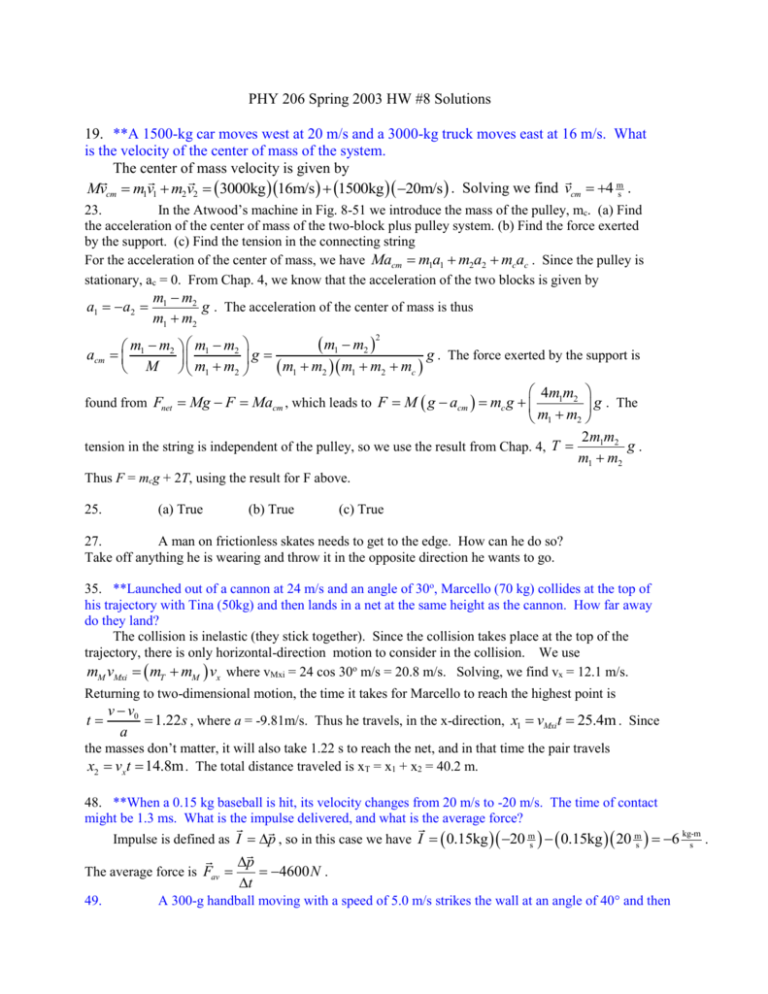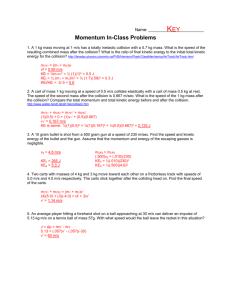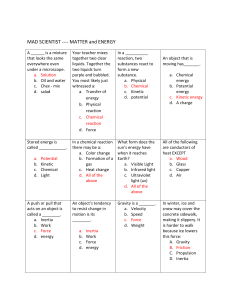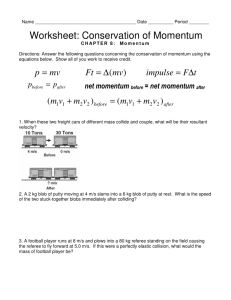Solutions for HW #8
advertisement

PHY 206 Spring 2003 HW #8 Solutions 19. **A 1500-kg car moves west at 20 m/s and a 3000-kg truck moves east at 16 m/s. What is the velocity of the center of mass of the system. The center of mass velocity is given by Mvcm m1v1 m2v2 3000kg 16m/s 1500kg 20m/s . Solving we find vcm 4 ms . 23. In the Atwood’s machine in Fig. 8-51 we introduce the mass of the pulley, mc. (a) Find the acceleration of the center of mass of the two-block plus pulley system. (b) Find the force exerted by the support. (c) Find the tension in the connecting string For the acceleration of the center of mass, we have Macm m1a1 m2a2 mcac . Since the pulley is stationary, ac = 0. From Chap. 4, we know that the acceleration of the two blocks is given by a1 a2 m1 m2 g . The acceleration of the center of mass is thus m1 m2 m1 m2 m m2 m1 m2 1 g . The force exerted by the support is g m1 m2 m1 m2 mc M m1 m2 2 acm 4m1m2 g . The m1 m2 2m1m2 g. tension in the string is independent of the pulley, so we use the result from Chap. 4, T m1 m2 found from Fnet Mg F Macm , which leads to F M g acm mc g Thus F = mcg + 2T, using the result for F above. 25. (a) True (b) True (c) True 27. A man on frictionless skates needs to get to the edge. How can he do so? Take off anything he is wearing and throw it in the opposite direction he wants to go. 35. **Launched out of a cannon at 24 m/s and an angle of 30o, Marcello (70 kg) collides at the top of his trajectory with Tina (50kg) and then lands in a net at the same height as the cannon. How far away do they land? The collision is inelastic (they stick together). Since the collision takes place at the top of the trajectory, there is only horizontal-direction motion to consider in the collision. We use mM vMxi mT mM vx where vMxi = 24 cos 30o m/s = 20.8 m/s. Solving, we find vx = 12.1 m/s. Returning to two-dimensional motion, the time it takes for Marcello to reach the highest point is t v v0 1.22 s , where a = -9.81m/s. Thus he travels, in the x-direction, x1 vMxit 25.4m . Since a the masses don’t matter, it will also take 1.22 s to reach the net, and in that time the pair travels x2 vxt 14.8m . The total distance traveled is xT = x1 + x2 = 40.2 m. 48. **When a 0.15 kg baseball is hit, its velocity changes from 20 m/s to -20 m/s. The time of contact might be 1.3 ms. What is the impulse delivered, and what is the average force? kg-m Impulse is defined as I p , so in this case we have I 0.15kg 20 ms 0.15kg 20 ms 6 s . The average force is Fav 49. p 4600 N . t A 300-g handball moving with a speed of 5.0 m/s strikes the wall at an angle of 40 and then bounces off with the same speed at the same angle. It is in contact with the wall for 2 ms. What is the average force exerted by the ball on the wall? The perpendicular component of the momentum is important here, pperp = mv cos = 1.15 kg-m/s. In bouncing off, the change in momentum is given by p = pf – pi = (-1.15 kg-m/s) – (1.15 kg-m/s) = -2.3 kg-m/s. The magnitude of the average force is p/t = 1150 N. 55. (a) False (b) True (c) True 67. **A 3-kg block with speed 4 m/s makes an elastic collision with a stationary block of mass 2 kg. Use conservation of momentum and the relative velocity relations to find the velocity of each block after the collision. Check by using conservation of kinetic energy. The relative speed of approach is given by vapproach = (0 – 4) m/s = -vrecession = -v2f + v1f. Conservation of momentum is written m1v1i m1v1 f m2v2 f . Solving these two together, we find v2f = 4.8 m/s, and therefore v1f = 0.8 m/s. For this special case of one mass initially at rest, equations 8-30 are relevant; be careful about using this result, since it is valid only for the special case. The initial kinetic energy is given by Ki 12 m1v12i 24J . The final kinetic energy is K f 12 m1v12f 12 m2v22 f 0.96J 23.04J=24 J . 69. A block of mass m1 = 2 kg has a speed of 10 m/s. Moving in the same direction with a speed of 3 m/s is a block of mass m2 = 5 kg. A massless spring, k = 1120 N/m is attached to the second block. (a) Before the collision, what is the velocity of the center of mass? (b) After the collision, the spring is compressed by a maximum amount x. What is x? (c) The blocks separate. What are the final velocities of the blocks? Initially the velocity of the center of mass is vcm m1v1 m2v2 5m/s . At the point of maximum spring M compression, the two blocks move together with the same velocity, which must necessarily be the center-ofmass velocity. Conservation of energy tells us that Ki ET K cm U spring . The initial kinetic energy is Ki = ½ m1v1i2 +½ m2v2i2 = 100 J + 22.5 J = 122.5 J. The center-of-mass kinetic energy is Kcm = ½ Mvcm2 = 87.5 J. Thus the spring potential energy is Usp = 35 J = ½ k (x)2. Using this relation, x = 0.25 m. The total kinetic energy of the center of mass remains constant, as does the momentum. The relative speed of approach is 3 m/s – 10 m/s = -7 m/s. This is equal to -vrecession = -(v2f – v1f). From conservation of momentum, Mvcm m1v1 f m2v2 f . Substituting v2 f 7m/s v1 f , we solve to find v1f = 0 m/s and thus v2f = 7 m/s. 105. **A 4-kg fish swims at 1.5 m/s to the right and swallows a 1.2 kg fish swimming at 3 m/s to the left. What is the velocity of the larger fish after lunch? This is an inelastic collision, so we know that the final velocity is common to the two fish. Momentum is conserved, m1v1i m2v2i m1 m2 v f . Taking into the account the velocity sign for fish 2, we find vf = 0.46 m/s. 108. A 3000-kg shark moves at 3.0 m/s vertically downward and eats a 200-kg fish moving at 8.0 m/s horizontally. What is the angle and final speed at which the shark moves after dinner? This is an inelastic collision in two dimensions. We can write m2v2 x m1 m2 vxf , since the shark (fish 1) has no initial x-direction motion. Solving gives us vxf = 0.5 m/s. In the y-direction we have m1v1 y m1 m2 vyf , which gives us vyf = -2.81 m/s. The angle with respect to the vertical 2 0.5 2 m 10.1 and the speed is v f 0.5 2.81 2.84 s . 2.81 is tan 1 112. **A pendulum with bob of mass 1 kg and length 2 m swings from a horizontal position and hits a block of mass 1 kg resting on a rough shelf ( = 0.1). Assuming the collision is perfectly elastic, (a) what is the velocity of the block just after impact? (b) How far does the block move before coming to rest? The initial potential energy of the pendulum is U = mgh = 19.6 J. As the pendulum reaches the lowest point, it has kinetic energy equal to this potential energy. We can find the speed from conservation of energy: v1 2 gh 6.26m/s . (a) From conservation of momentum we have Pi = Pf. Using Eqns. 8-30, we see that v1f = 0 m/s and v2f = 6.26 m/s. (b) The initial kinetic energy of the block is thus Ki = 19.6 J. This is the energy dissipated by friction, -fs = -19.6 J. The frictional force is f = Fn = mg. We can solve this for the distance s = 20 m. 114. **A 15-g bullet traveling at 500 m/s hits an 0.8-kg block balanced on the edge of a table of height h = 0.8 m. How far does the block go before hitting the floor? In the inelastic collision we have mb vi mb mB v f from which we find vf = 9.2 m/s. The height above the floor is 0.8 m so we can calculate the time needed to hit the floor from y which allows us to find t = 0.40 s. The x-direction distance is found from x vxt 9.2 ms 0.4s 3.72m . 1 2 a yt , 2





